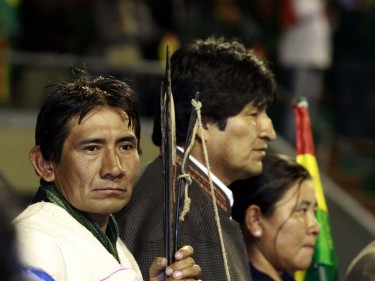In October 2011, the President of Bolivia, Evo Morales, signed off a law known as “Ley Corta” declaring the Indigenous Territory National Park Isiboro Sécure “untouchable”. The Bill came up after an indigenous march led by the Confederation of Indigenous Peoples of Bolivia (CIDOB in Spanish) covered more than 600 kilometres to the Seat of government in La Paz demanding to stop a road project attempting to cross through the middle of the National Park.
The indigenous organisations against the road gained notorious attention and support from civil society after the government repressed the march with excessive violence, as biologist and blogger Mauricio Pacheco Suárez commented on his blog [es]:
[…] el Gobierno contraataca y demuestra que no va a dar su brazo a torcer en sus intenciones desarrollistas. Ha montado una “Contramarcha” a favor de la carretera con las comunidades cocaleras asentadas en el área protegida, además de algunas comunidades indígenas (agrupadas en torno al CONISUR) que optaron voluntariamente por producir coca ilegal, y no pertenecer al Territorio Comunitario de Origen TCO-TIPNIS, y están buscando hasta debajo de las piedras, mecanismos que le permitirían a[l presidente] Evo [Morales] construir finalmente su carretera, con las desastrosas consecuencias ambientales previstas
Thus, the Ley Corta became a breaking point between the social-movement backed Evo Morales government and indigenous from lower lands, including some officialist indigenous MPs. The last word on this TIPNIS conflict, however, had not been said.

President Evo Morales meets indigenous groups over TIPNIS dispute. Photo by Wara Vargas Lara, copyright Demotix (01/02/12).
In early January 2012 a pro-road march organised by the newly-gathered Indigenous Council from the South (Conisur in Spanish) began its 500-kilometre-march from the Southern borders of the National Park to La Paz, calling for the road to be built. This action was strongly criticised, as blogger Carwil Bjork-James describes, by other indigenous organisations claiming that it was fully backed by the government as a political manoeuvre.
Members of Conisur and CIDOB, along with MPs and government officials, met together in La Paz in order to negotiate a way out. Negotiations did not reach a balanced result. A new law was signed off on February 11, 2012, through which a previous consultation will be held within 120 days only among the inhabitants of the National Park. Tsiname, Yuracaré and Mojeño-trinitario indigenous will decide whether the TIPNIS remains untouchable, and no road will be built, or, conversely, this category is suspended and the road, already under construction, carries on.
Meanwhile, the debate is reactivated on Social Media platforms. Marcelo N. Claure (@marceloncr2) comments on Twitter [es]:
[…] sin ser partidario del MAS, creo que la carretera puede ser beneficiosa para el país
Gabriel Espinoza Y. (@G_ESPINOZA) replies [es]:
tienes razón, puede ser beneficiosa, de hecho la gente del #TIPNIS esta de acuerdo con carretera, pero no por el medio del #TIPNIS
Both arguments are under debate. As La Paz-based blogger, Dario Kenner shares on his blog:
The focus in the last few days has been on the proposal by CONISUR along with the Presidents of the Senate and Congress (who are members of the governing MAS party led by President Evo Morales) to approve a law on prior consultation of indigenous peoples. Who should be consulted and how has generated plenty of debate.
In trying to understand the current conflict I spoke to indigenous leaders of both CONISUR and CIDOB (read both interviews).
CIDOB, Human Rights Assembly and other civil organisations have declared themselves against this new law, and claim that the road may be built only if it surrounds the National Park, unlike the original project designed right through the middle of the Natural Reserve, as illustrated in this infographic, which holds a very rich biodiversity.







11 comments